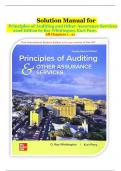Exam (elaborations)
Solution Manual for Principles of Auditing and Other Assurance Services 22nd Edition by Ray Whittington, Kurt Pany, Chapters 1 - 21, Complete ( Newest Version)
Solution Manual for Principles of Auditing and Other Assurance Services 22nd Edition by Ray Whittington, Kurt Pany, Chapters 1 - 21, Complete ( Newest Version)
[Show more]




